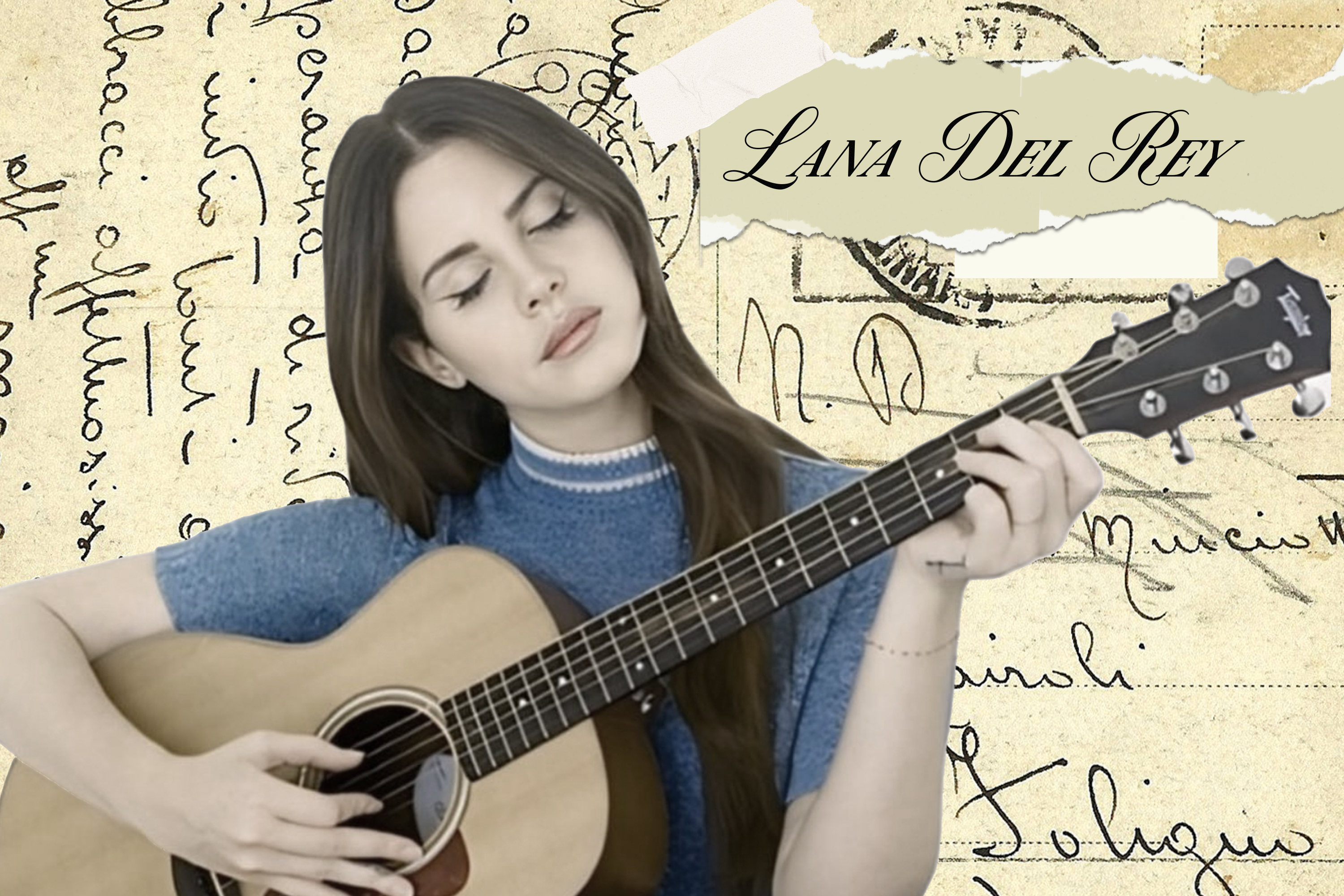Peeling back the layers of Lana Del Rey’s elusive melodies defines her persona and navigates the dance between the price of fame, authenticity and the blurred lines of reality.
In the ever-evolving lens of popular culture, Lana Del Rey stands as a luminous picture of cinematic nostalgia and haunting melodies, blending to create a musical experience that resonates with millions of people around the world.
From the breathy tones of “Video Games” to the cinematic storytelling of “Summertime Sadness”, Lana’s music is a journey through the emotional landscapes of love, loss and the pursuit of the American Dream. Her portrayal of the concept presents a dreamy cinematic promise of a better life, often centered around generational wealth, mid-century aesthetics and vintage Hollywood. However, behind the enchanting melodies and her glamorous persona lies a complex narrative of the price of fame, industry biases and the performative nature of stardom that draws the tensions between illusion and reality into question.
Lana Del Rey, born Elizabeth Woolridge Grant, emerged from the shadows of obscurity, redefining the singer-songwriter genre with her unique blend of retro aesthetics and contemporary melancholy. However, as her star began to ascend, so did the scrutiny and expectations of the music industry.
Her jump into the music scene saw Lana navigating the vibrant nightlife of her hometown Lake Placid bars and performing in clubs under various monikers, including Lizzy Grant, Sparkle Rope Jump Queen, and Lizzy Grant and the Phenomena. Playing in Brooklyn clubs, she cultivated a devoted underground following, laying the foundation for her distinctive style. After somewhat successful traction in London and the release of “Kill Kill,” in 2008 under Lizzy Grant, her rebranding as Lana Del Rey in 2011, coupled with the release of “Video Games,” was what ultimately catapulted her into the spotlight.
The three songs off the EP were later included on “Lana Del Ray a.k.a. Lizzy Grant,” an album that was deleted shortly after its release.
However, before pursuing these musical endeavors, Lana disclosed her past struggle with alcohol addiction, revealing that her parents took the decisive step of sending her to Kent School, a stringent boarding school in Connecticut, at the tender age of 14 to help her overcome her drinking habits. During those tumultuous years, Lana admitted to being a heavy drinker, consuming alcohol daily and often in solitude.
She expressed that she initially found the concept of drinking alone to be enticing, considering it “so fucking cool.” The impact of this period in her life is reflected in much of her work on the album ‘Born To Die.’
Lana confessed, “My parents were worried, I was worried. I knew it was a problem when I liked it more than I liked doing anything else. I was like, ‘I’m fucked. I am totally fucked.’” She described the initial allure of embracing a dark side as exciting but acknowledged that the dark side inevitably prevails when indulged. Lana emphasized that this lifestyle constituted a different way of living, likening it to being a different species of person. Reflecting on this time, she declared it the “worst thing that ever happened” to her.
This revelation comes amid controversy surrounding Lana Del Rey’s nude cover on British GQ, where she was named Woman of the Year. The cover has sparked criticism on social media and from outlets like Jezebel, accusing it of perpetuating “internalized sexism.” The accompanying photos, including one depicting a man with his hand around her neck, have further fueled the controversy.
Thus,her journey from Lizzy Grant to Lana Del Rey was not merely a name change but a transformation into an image that would captivate audiences, sparking conversations about authenticity in the realm of fame.
The enigmatic allure of Lana Del Rey draws parallels to the iconic figures of the past, notably Marilyn Monroe and John F. Kennedy; Monroe, with her captivating beauty and tragic end, and JFK, with the charisma that defined an era. Both embody the complex relationship between fame and personal sacrifice. Lana’s music and character reflect these timeless themes, exploring the tension between public perception and private struggles.
The pinnacle of Lana Del Rey’s career (so far) was marked by her Grammy Award-nominations for her 2012 EP “Paradise” and more recently for her song A&W. a However, the subsequent snub due in part to her decade-old Saturday Night Live performance stirred commentary about the industry’s biases and the challenges faced by artists who defy conventional norms.
In a since deleted tweet, Actress Juliette Lewis harshly exclaimed a stance widely embraced by the media:“Wow watching this ‘singer’ on SNL is like watching a 12 year old in their bedroom when they’re pretending to sing and perform. #signofourtimes”
Lana’s journey from Grammy nominee to overlooked artist is emblematic of the broader struggles within the music industry, where artistic merit often takes a back seat to commercial appeal.
One of the pivotal moments in Lana Del Rey’s career that exemplifies the dichotomy of fame and its repercussions is the release of her music videos for “National Anthem” and “Candy Necklaces.” These visual narratives not only complement the songs but also serve as windows into Lana’s world, blurring the lines between reality and performance.
The music video for “National Anthem” is a bold reimagining of the American Dream, with Lana playing the roles of Jacqueline Kennedy and Marilyn Monroe throughout the course of an extramarital affair and horrific death of John F. Kennedy.
The juxtaposition of these two iconic figures creates a visual commentary on the complexities of female identity, as well as the expectations placed upon women in the public eye. Lana, in her dual role, becomes a modern-day muse, embodying the aspirations, tragedies and seduction associated with these historical figures.
Norma Jeane Mortenson, who would later become the iconic Marilyn Monroe, faced a reinventive journey to stardom. Born into a challenging environment and navigating a troubled childhood, Monroe sought refuge in dreams of fame. Her transformation into Marilyn Monroe as a marketing tool made by the industry flagged the intersection of vulnerability and glitz Mortenson grappled with societal expectations of “becoming her,” referring to herself as Monroe.
Concurrently, John F. Kennedy (JFK), the President of the United States,who had an affair with Monore and suffered a death by assassination, embodied political stardom. Their paths converged in a complex scandal, encapsulating the challenges of fame, political power, and the intertwining of public and private lives.
Jackie O, Jacqueline Kennedy Onassis, adds another layer to the intricate narrative connecting JFK, Marilyn Monroe, and the cross over of vulnerability and glamor. As the First Lady, she navigated the same complexities in addition to the pressures of being the picture of a traditional wife and mother. Her actions and inactions were magnified while she steadfastly embodied grace amidst the tumultuous landscape of American politics.
Her resilience in the face of public scrutiny for JFK’s affair, intertwined with the iconic “Happy Birthday, Mr. President” moment that Lana Del Rey recreates, highlights the intricate dance between authenticity and curated public personas.
Monroe’s life became emblematic of the pressures faced by women in the entertainment industry, while JFK’s presidency and Jackie O exemplified the intersection of charisma and political influence.
Their stories illuminate the dualities and challenges inherent in fame, from Monroe’s pursuit of a Hollywood dream to JFK’s and Jackie O’s public roles in the ideal “First Family,” revealing the line between personal authenticity and the expectations imposed by the spotlight.
In the context of Lana Del Rey’s “National Anthem,” Del Rey skillfully reimagines JFK’s family life. By delving into the iconography of the Kennedys, she reconstructs a visual narrative that captures the essence of the era. The video’s juxtaposition of opulence and tragedy echoes the turbulent times, with Lana’s interpretation of the Kennedys’ family dynamics serving as a reflection on the complexities of public and private lives.
Notably, the inclusion of the film depicting JFK’s assassination adds a haunting layer, blending the personal with the political. Lana Del Rey, in her masterful storytelling, invites viewers to contemplate the intersection of beauty, power and tragedy in American history, turning the music video into a captivating visual journey through the nuances of fame and historical memory.
In an exclusive interview with the director of “National Anthem,” it becomes evident that the video was a deliberate attempt to challenge conventional norms and perceptions. The director, in conversation with MTV, revealed the meticulous planning behind each scene and the intention to blur the lines between reality and fantasy. Lana, much like the characters she portrays, becomes a reflection of society’s fascination with glamor and tragedy, questioning the price one pays for such a mesmerizing facade.
The “Candy Necklaces” music video, as reported by Rolling Stone, is another cinematic masterpiece, diving into Lana Del Rey’s exploration of the dichotomy between innocence and corruption. Set against the backdrop of a sultry 1960s nightclub, the video unfolds like a vintage film, with Lana as the central figure navigating through a world of decadence and desire. The candy necklaces, symbolic of fleeting pleasures, become a metaphor for the fragility of fame and the allure of superficial indulgence.
The visual storytelling in both these music videos reinforces Lana Del Rey’s commitment to her artistic vision, even in the face of industry expectations. However, this commitment comes at a cost, as the public eye scrutinizes every move, dissecting the authenticity of her persona and the narratives she weaves.
The music video was subjected to great criticism due to Lana’s Elizabeth Short parallel. Viewers scrutinized the choice on Reddit by stating, “God forbid we think it’s a little insensitive to make a music video with the theme ‘meta Black Dahlia.’ They continued: “The press lied to her mom and told her she won a beauty pageant to get personal information on her daughter and used it to kill her.”
The visual narrative of “Candy Necklace,” intertwines with elements reminiscent of beauty pageants, a reflection of the societal pressures and expectations placed on women. The juxtaposition of glamor and tragedy mirrors the dichotomy present in Elizabeth Short’s life, as she aspired to a Hollywood dream that ultimately led to her tragic demise.
Lana Del Rey’s resemblance in the video serves to comment on the complexities of femininity, fame, and the haunting echoes of historical events like the Black Dahlia murder. Through her music Del Rey continues to weave a tapestry that connects the past and present, inviting contemplation on the darker facets of American culture.
By doing so, the performative nature of stardom becomes a double-edged sword, granting fame and recognition, but also subjecting artists to relentless scrutiny and judgment.
Lana Del Rey’s journey from the Lizzy Grant “era,” sheds light on her transformation from a struggling artist to a global sensation. The evolution of Lana’s music and image emphasizes the challenges faced by artists in navigating the fine line between authenticity and marketability. Lizzy Grant becomes a testament to Lana’s resilience and determination to carve her own path, even when faced with the pressures of conformity.
The complexity of Lana Del Rey’s persona is further dissected in the exploration of how Lizzy Grant became Lana Del Rey. Lana’s evolution becomes a case study in the performative nature of fame, where artists are not merely creators but also actors playing a role dictated by industry expectations.
As industry realities continue to reverberate, Lana Del Rey remains an enigmatic figure, symbolizing both the allure and the pitfalls of the limelight. While she continues to navigate the labyrinth of fame and artistic expression, her journey serves as a mirror reflecting the broader realities of the music industry. The Grammy nod and subsequent snub, the thought-provoking music videos and the evolution from Lizzy Grant to Lana Del Rey all contribute to a narrative that goes beyond the surface glamor of stardom.

















